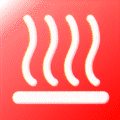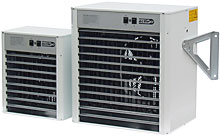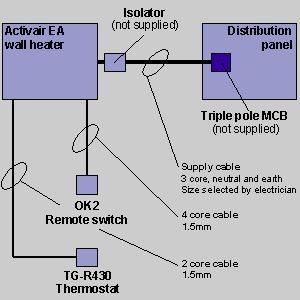
| ||||
W. Tombling Ltd.
Wembley House
Dozens Bank
West Pinchbeck
Spalding
Lincolnshire
PE11 3ND
U.K.


You are here:- home > heater index > electric wall mounted heaters > wall heater faq
VEA wall heaters - common questions
This page answers the most common questions we are asked about our VEA wall heaters. It contains information that is useful for both users and installers.
Can I install an VEA wall heater myself?
VEA wall heaters must be installed by a qualified electrician in accordance with local wiring regulations.How do I check my electricity supply is suitable?
Consult your electrician; you need a 400V 3 phase 50Hz electricity supply, capable of supplying the following currents:VEA6 - 8.8A per phase
VEA9 - 13.1A per phase
VEA14 - 20.4A per phase
VEA21 - 30.5A per phase
VEA30 - 43.5A per phase
What do they cost to run?
To determine the cost for one hours continuous operation at full output, multiply the heater size in Kw by the price you pay for one unit of electricity (Kwh).i.e. VEA9 is 9Kw, assuming you pay 0.20p per unit of electricity, the running cost is:
Continuous running cost per hour = Kw x unit cost of electricity = 9 x 0.20 = £1.80
Will an VEA wall heater work with a 230V single phase supply?
No, VEA wall heaters can only be used on a 400V 3 phase and neutral 50Hz electrical supply.How is the VEA wall heater connected to my electricity supply?
VEA wall heaters are permanently connected to your electricity supply via
a 3 phase, neutral and earth cable.Your electrician will choose a suitable cable type and size, based on phase current (see above), its length, installation method, ambient temperature, voltage drop, earth loop impedance, self-heating under fault currents, etc.
A suitably rated isolator (not supplied) should be positioned adjacent to the heater.
Overcurrent protection should be supplied by a suitably rated triple pole type B mcb (not supplied).
Connect the OK2 remote switch (included with heater) with a 4 core 1.5mm cable.
Connect the TG-R430 thermostat (included with heater) with a 2 core 1.5mm cable. Important! This cable must be routed away from all other cables.
Click on the icon, for a printer friendly wiring diagram.
![]()
Can I control VEA wall heaters with a time switch?
Version 2 heaters - Click on the icon, for a printer friendly wiring diagram.
![]()
Version 3 heaters - Click on the icon, for a printer friendly wiring diagram.
![]()
Where should the air sensor be sited?
The TG-R430 air sensor should be sited approximately 1.2m (4ft.) above floor level. When choosing a spot for it make sure it is not affected by cold drafts from doors and windows, or the warm air output from the heater.Generally it is best to site the sensor towards the centre of the building and to avoid mounting it on outside walls.
I don't need the TG-R430 remote sensor, do I have to fit it?
The TG-R430 is an adjustable air temperature sensor, it is a very important part of your heaters control system. It must always be fitted, do not be tempted to omit it, or short circuit its terminals. In the unlikely event it becomes faulty it must be replaced with an identical device.
Are there any mounting restrictions for VEA wall heaters?
VEA wall heaters should be at least 200mm from the ceiling and 125mm from the wall. They should not blow directly on to any combustible material. See page 2 of the installation manual for a diagram.VEA wall heaters should be protected from water jets or drips.
Can I sit an VEA heater on the floor?
VEA heaters are designed for permanent installation on a wall. We don't recommend you stand them on the floor, use a heater specifically designed to sit on the floor such as our portable fan heaters or blowers.
My VEA wall heater has just been delivered, the OK2 control switch and TG-R430 thermostat are missing!
Remove the top of the heater, they are put inside for shipping so they are not lost.How do I get the fan to run without heat?
Set the fan switch on the front of the wall heater to 'continuous operation'. The OK2 switch will then turn the fan on and off.Where can I get a copy of the user/installation manual?
Click on this link to download a copy in PDF format.
What is the clicking/clunking noise coming from my wall heater?
The element contactors inside the VEA wall heater turning on/off, this is normal and nothing to be concerned about.There's no heat coming from my wall heater, what's wrong?
Is the thermostat demanding heat? Turn it to maximum. Check the OK2 remote switch is set to 'full heat'.If the wall heater is still blowing cold air, the internal overheat cut out may have operated. Proceed as follows:
Turn the electricity supply off at the isolatorA build up of dust inside the wall heater can cause the over heat trip to operate, in which case the heater should be cleaned.
Investigate why the cut out has operated and correct the fault
Reset the cut out with the button on the back of the heater
Restart the heater, in fan only mode, if the fan is OK turn on the heat
My VEA wall heater is not as hot as I expected, how do I check it?
See how hot should my heater be?
Our wall heaters use powerful fans to recirculate high volumes of air. This gives excellent heat distribution, with minimum stratification, but does mean the temperature lift through the heater is lower than some people expect.It is easy to check the wall heater is working correctly:
For electricians:
With the OK2 remote switch set to full heat, the TG-R430 temperature sensor to maximum, and fan switch on the wall heater set to high speed, use a current clamp to measure the current drawn. Compare the results to the phase currents given above.
For users:
With the OK2 remote switch set to full heat, the TG-R430 temperature sensor to maximum, and the fan switch on the wall heater set to low speed, use a thermometer to measure the inlet and outlet air temperatures. The temperature lift through the wall heater should be approximately:
EA6 - 17C
EA9 - 26C
EA14 - 20C
EA21 - 30C
EA30 - 30C
It is very difficult to get accurate readings, take several measurements and use the average. Using this method an error of 4 to 5C should be expected.
You are here:- home > heater index > electric wall mounted heaters > wall heater faq
If you found this page useful, please take a moment
to tell a friend or colleague about it.
Copyright © 2004/10, W. Tombling Ltd.